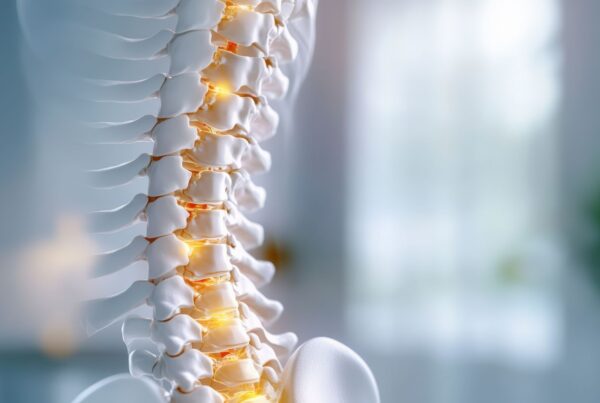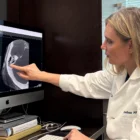Cervical radiculopathy affects millions of people, causing debilitating pain that radiates from the neck down into the shoulders, arms, and hands. If you’re experiencing sharp, burning pain that travels from your neck into your arm, or numbness and tingling in your fingers, you may be dealing with this condition.
Understanding cervical radiculopathy is the first step toward finding relief and returning to your normal activities. This comprehensive guide explains what causes cervical spine (sometimes called c spine) radiculopathy, how to recognize the symptoms, and what treatment options can help you regain your quality of life.
What Is Cervical Radiculopathy?
Cervical radiculopathy occurs when a nerve root in the cervical spine (neck region) becomes compressed, inflamed, or damaged. The cervical spine contains seven vertebrae (C1-C7), and nerve roots exit between each vertebra to control sensation and movement in your shoulders, arms, and hands.
When these nerve roots become pinched or irritated, they send pain signals that can be felt far from the actual source of the problem. This is why cervical radiculopathy often causes symptoms that extend down your arm rather than staying localized in your neck.
Understanding C Spine Nerve Compression
The cervical spine is a complex structure where nerve roots must pass through narrow openings called neural foramina. These openings can become narrowed due to various factors, leading to c spine nerve compression. When compression occurs, it interferes with the nerve’s ability to function properly, resulting in the characteristic symptoms of cervical radiculopathy.
Recognizing Cervical Radiculopathy Symptoms
The symptoms of cervical radiculopathy can vary depending on which nerve root is affected, but common signs include:
Pain Patterns:
- Sharp, burning pain that radiates from the neck into the shoulder and arm
- Pain that worsens with certain neck movements
- Aching sensation that may be constant or intermittent
- Pain that intensifies when coughing, sneezing, or straining
Neurological Symptoms:
- Numbness and tingling in specific areas of the arm and hand
- Weakness in the arm, hand, or fingers
- Loss of reflexes
- Difficulty with fine motor tasks like writing or buttoning clothes
Location-Specific Symptoms by Nerve Root:
- C5 nerve root: Shoulder and upper arm pain, deltoid weakness
- C6 nerve root: Thumb-side pain extending to the forearm, bicep weakness
- C7 nerve root: Middle finger numbness, tricep weakness
- C8 nerve root: Pinky-side numbness, hand grip weakness
Can Cervical Radiculopathy Cause Foot Numbness?
While cervical radiculopathy primarily affects the arms and hands, some patients wonder if it can cause foot numbness. Generally, cervical nerve root compression does not directly cause foot symptoms, as the nerves controlling the legs originate from the lumbar spine. However, severe cervical spinal cord compression (cervical myelopathy) can potentially affect leg function, though this represents a different and more serious condition.
What Causes Cervical Radiculopathy?
Several factors can lead to c spine impingement and nerve root compression:
Age-Related Changes
- Cervical disc degeneration: Discs lose height and elasticity over time
- Bone spurs (osteophytes): Extra bone growth that narrows nerve pathways
- Facet joint arthritis: Joint inflammation that can compress nearby nerves
Acute Injuries
- Herniated discs: When disc material pushes out and presses on nerve roots
- Cervical strain: Can cervical strain cause radiculopathy? Yes, severe neck strain can lead to inflammation and temporary nerve compression
Structural Issues
- Cervical stenosis: Narrowing of the spinal canal or neural foramina
- Cervical disc disorder with radiculopathy: When disc problems directly compress nerve roots
- Spondylosis: General wear and tear of the cervical spine
Risk Factors
Several factors increase your likelihood of developing cervical radiculopathy:
- Age (most common between 40-60 years old)
- Previous neck injuries
- Poor posture, especially from prolonged computer use
- Smoking (reduces blood flow to spinal structures)
- Heavy lifting or repetitive neck motions
- Genetic predisposition to spinal degeneration
It's time to get back
to doing what you love.
Diagnosing Cervical Radiculopathy
Accurate diagnosis is crucial for effective treatment. Your evaluation typically includes:
Clinical Examination
Your neurosurgeon will assess:
- Range of neck motion
- Muscle strength in your arms and hands
- Reflexes
- Sensation patterns
- Specific tests like Spurling’s test to reproduce symptoms
Imaging Studies
- MRI (Magnetic Resonance Imaging): Provides detailed images of soft tissues, discs, and nerve roots
- CT scan: Shows bone structures clearly
- X-rays: Reveal alignment issues and bone spurs
Electrodiagnostic Tests
- EMG (Electromyography): Measures muscle electrical activity
- Nerve conduction studies: Assess nerve function and identify the specific affected nerve root
Treatment Options for Cervical Radiculopathy
Treatment approaches range from conservative management to surgical intervention, depending on the severity and duration of symptoms.
Conservative Treatment
Medications:
- Anti-inflammatory drugs (NSAIDs) to reduce swelling
- Muscle relaxants for muscle spasms
- Neuropathic pain medications for nerve-related discomfort
- Short-term corticosteroids for severe inflammation
Physical Therapy:
- Cervical traction to decompress nerve roots
- Strengthening exercises for neck and shoulder muscles
- Posture training and ergonomic education
- Range of motion exercises
Injections:
- Cervical epidural steroid injections: Deliver anti-inflammatory medication directly to the affected area
- Selective nerve root blocks: Target specific nerve roots for both diagnosis and treatment
Surgical Treatment
When conservative treatments fail to provide adequate relief after 6-8 weeks, or if you have progressive neurological deficits, surgical intervention may be recommended.
Anterior Cervical Discectomy and Fusion (ACDF):
- Removes the problematic disc through a front-of-neck approach
- Relieves pressure on compressed nerve roots
- Fuses adjacent vertebrae for stability
Posterior Cervical Foraminotomy:
- Enlarges the neural foramen through a back-of-neck approach
- Preserves disc and natural neck motion
- Minimally invasive option for specific cases
Cervical Disc Replacement:
- Replaces the damaged disc with an artificial one
- Maintains neck motion while relieving nerve compression
Recovery and Prognosis
The outlook for cervical radiculopathy varies based on several factors:
Conservative Treatment Recovery
- Many patients experience significant improvement within 4-6 weeks
- Complete resolution of symptoms may take 2-3 months
- Early treatment typically leads to better outcomes
Surgical Recovery
- Pain relief often occurs immediately after surgery
- Full recovery typically takes 6-12 weeks
- Return to normal activities is usually possible within 3-4 months
Factors Affecting Recovery
- Age and overall health status
- Duration of symptoms before treatment
- Severity of nerve compression
- Compliance with treatment recommendations
Preventing Cervical Radiculopathy
While not all cases are preventable, you can reduce your risk by:
Maintaining Good Posture:
- Keep your computer screen at eye level
- Use ergonomic workstation setups
- Take frequent breaks from prolonged sitting
Strengthening Your Neck:
- Perform regular neck and shoulder exercises
- Maintain core strength to support spinal alignment
- Practice stress-reduction techniques to prevent muscle tension
Lifestyle Modifications:
- Avoid smoking, which impairs spinal health
- Maintain a healthy weight to reduce spinal stress
- Sleep with proper neck support
When to Seek Medical Attention
Contact a neurosurgeon promptly if you experience:
- Sudden onset of severe neck and arm pain
- Progressive weakness in your arm or hand
- Loss of grip strength or difficulty with fine motor tasks
- Symptoms that interfere with sleep or daily activities
- Numbness or tingling that persists or worsens
Advanced Treatment at Neurosurgeons of New Jersey
At Neurosurgeons of New Jersey, our specialized team understands that each case of cervical radiculopathy is unique. We provide comprehensive evaluations and personalized treatment plans that prioritize your comfort and recovery goals.
Our board-certified neurosurgeons utilize the latest minimally invasive techniques when surgery is necessary, focusing on faster recovery times and excellent outcomes. We accept most major insurance plans and have multiple convenient locations throughout New Jersey and New York.
If you’re experiencing symptoms of cervical radiculopathy, don’t wait for the condition to worsen. Early intervention often leads to better outcomes and can help you return to your active lifestyle more quickly.
Call 551-284-3265 today to schedule your consultation and take the first step toward relief from cervical radiculopathy.
FAQs
How long does cervical radiculopathy take to heal?
Recovery time varies significantly depending on the severity of nerve compression and treatment approach. With conservative treatment, many patients see improvement within 4-6 weeks, though complete resolution may take 2-3 months. Surgical patients often experience immediate pain relief, with full recovery typically occurring within 6-12 weeks. Factors like age, overall health, and how quickly treatment begins all influence healing time.
Can cervical radiculopathy be cured permanently?
Many cases of cervical radiculopathy can be successfully treated with long-lasting results. Conservative treatments like physical therapy and injections can provide permanent relief, especially when the condition is caught early. Surgical interventions, such as ACDF or foraminotomy, often provide definitive treatment by addressing the underlying structural problem. However, age-related spinal changes may continue, so maintaining good posture and neck strength is important for preventing recurrence.
What happens if cervical radiculopathy goes untreated?
Leaving cervical radiculopathy untreated can lead to permanent nerve damage, chronic pain, and progressive weakness in the affected arm. While some mild cases may resolve on their own, persistent nerve compression can cause irreversible changes to muscle function and sensation. Early intervention is crucial to prevent long-term complications and preserve nerve function.
Is cervical radiculopathy the same as a pinched nerve in the neck?
Yes, cervical radiculopathy is the medical term for what’s commonly called a “pinched nerve in the neck.” Both terms describe nerve root compression in the cervical spine that causes pain, numbness, and weakness radiating into the arm. The symptoms occur because the compressed nerve cannot function normally, sending abnormal signals that create the characteristic pain patterns.
Can stress and poor posture cause cervical radiculopathy?
While stress and poor posture don’t directly cause cervical radiculopathy, they can contribute to its development. Chronic stress leads to muscle tension that puts extra pressure on cervical structures, while poor posture (especially forward head posture from computer work) increases strain on cervical discs and joints. Over time, these factors can accelerate degenerative changes and increase the risk of nerve compression. Maintaining good posture and managing stress are important preventive measures.
Dr. Ty J. Olson, MD, FACS
Dr. David Estin, MD, FACS
Dr. Anthony Conte, MD
Dr. Christopher Gillis, MD, FRCSC, FAANS
Dr. Jonathan H. Lustgarten, MD

About Eatontown
Our team of board certified physicians, located in Eatontown, New Jersey, are dedicated to bringing you the latest developments and treatment options for spinal surgery. We strive to produce the most clarified & clear content to help you make informed decisions on your medical journey. The road to feeling like your true self should not feel lonely- Let us help you. Please call us to schedule a consultation and speak to one of our team members.






